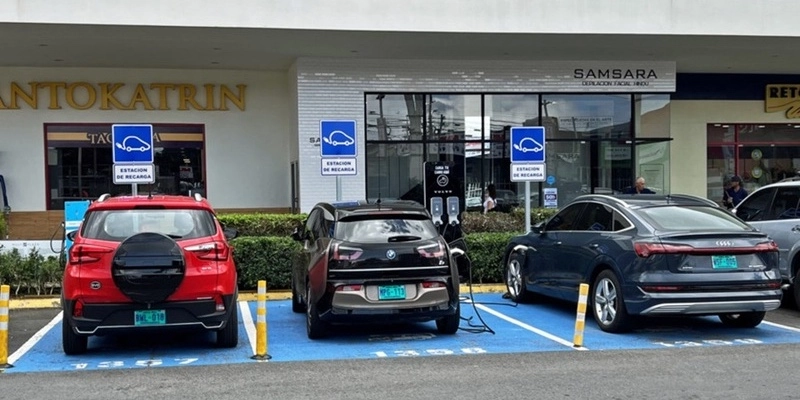While the path to electrification is a reality, progress is not happening at the same pace everywhere in the world.
In 2023, the European Union decided that the phase-out of combustion engines will be set for 2035.
This legislation seeks, first of all, to reduce greenhouse gas emissions by 55 per cent in the continent by 2030.
The goal is to raise that percentage to 100 per cent in 2035.
Meanwhile, in Latin America, these steps are slower, although they are still taking place.
Despite the times, the truth is that the region is little by little preparing itself for electrical alternatives.
The thing is that in countries like Colombia, Chile, Costa Rica or Mexico, growth in the sale of sustainable vehicles has already been observed for some years. An inclination towards the eMobility world.
The truth is that China stands as one of the countries with the best positioning in the electric mobility market and this place finds its correlation in the nations of South America.
In such a way that those automotive companies that disembark help diversify the offer of electric vehicles with lower prices for the user.
This is the case of the Asian firm Great Wall Automobile (GWM), which ended its production of vehicles with internal combustion engines in March 2022 with the purpose of focusing solely on new energies.
While in 2023, the company launched its first fully electric car in Brazil, expanding its model range. This year its local production begins.
Recently, GWM formalized its arrival in the Mexican market.
A similar case happens with its Chinese rival, BYD, which seeks to lead the market in Latin America with the upcoming installation of a production center in Brazil.
In addition, it also plans to establish a plant in Mexico, considering it a key market.
The Japanese company Toyota also plans to manufacture its electric models in that country.
In this deepening of the Asian manufacturers, it is also worth mentioning, among other announcements, that of Chery in Argentina, since it would install an electric vehicle factory there by 2025.
There are many more brands that are added to those mentioned, so without a doubt, the eastern firms have plans to monopolize the electrified motor business in Latin America.
For its part, the Stellantis group, one of the largest car manufacturers in the world, set the goal of selling only electric vehicles in Europe by 2030.
However, it does not yet plan to abandon the development of internal combustion engines.
It is a leader in the markets of Brazil, Argentina and Chile. In 2023, the Group’s total regional sales exceeded 878,000 vehicles, with a market share of 23.5 per cent.
With this investment, Stellantis – which also owns the brands Abarth, Alfa Romeo, Chrysler, Dodge, DS Automobiles, Lancia, Maserati, Opel, and Vauxhall – “will be increasingly prepared to design, develop, and produce modern automobiles in the region, while expanding its business.”
In March of this year, it announced that it will invest 6 billion dollars in the period 2025-2030, which represents a record figure not only for the Brazilian industry, but also for the region.
In Argentina, for example, the company acquired a 19.9 per cent stake in Argentina Litio y Energía S.A., a significant step towards sourcing a group of materials for sustainable batteries and thus meeting the electrification goals described in the global plan.
Meanwhile, Volkswagen (VW) will stop selling combustion engine vehicles in Europe between 2033 and 2035 to transition to electric cars.
But, according to its sales director, Klaus Zellmer, in an interview with the newspaper Münchner Merkur, this step will be carried out “a little later in the United States and China.
In South America and Africa, due to the absence of political and infrastructure framework conditions, it will take longer.”
Despite this, VW de México will invest 942 million dollars in its Puebla plant for the creation of a strategic electromobility center, with the aim of promoting the assembly of electric and hybrid cars and strengthening the North American region.
Also, a few days ago, the subsidiary of Volkswagen Trucks and Buses (Vwco) in Brazil announced that, starting in the second half of 2024, commercial production of e-Volksbus electric buses will begin .
By 2030, Ford states that it will only sell electric vehicles in Europe. Does it project the same for Latin America?
In this sense, Pedro Botero, sales manager of Ford Motor Colombia, when consulted by El Colombiano about one of the Government’s goals linked to all vehicles circulating in the country being electric by 2040, stated:
“I definitely see it very far away. I think that electric cars are going to continue growing, but perhaps there is an intermediate point before reaching them completely and that is hybrid technology.”
Even so, since October 2023, Mexico has been producing the Ford Mustang Mach-E, which means progress at the Latin American level in terms of sustainable mobility.
The multinational BMW intends that in 2030 “at least” 50 per cent of its global registrations correspond to electrified models.
In ten years, the brand plans to have ten million electric vehicles on the highways.
The German firm spent 800 million euros to build the High Voltage Battery Production Center for electric vehicles on Mexican soil.
According to the project announced last February, the Potosí plant will become the first in all of Latin America to manufacture electric cars and high-voltage batteries.
The electric car manufacturer founded in 2003 by Elon Musk has six large factories around the world, the four mentioned in the United States, one in Shanghai, China, and the other in Germany, on the outskirts of Berlin.
Beyond the fact that it is an automaker that was born electric, the arrival that Tesla projects on Mexican soil cannot be overlooked.
At the beginning of 2023, it announced that it will build its seventh plant on the outskirts of Monterrey, but the project has not progressed at the expected speed for now, despite the fact that the company has the land to build the factory.
Tesla’s original plan for its new plant in Mexico was to manufacture its new “affordable” electric model there for around 25,000 dollars, a prototype that Elon Musk considered key to facing growing competition from Chinese brands.
But now, that cheaper car project would have gone under review to make way for another initiative of the businessman, autonomous robotaxis.
The choice of Mexico as a destination for a new plant, however, makes sense based on the high development of the automotive and auto parts industry in that country and the possibility of exporting without tariffs to the United States.






